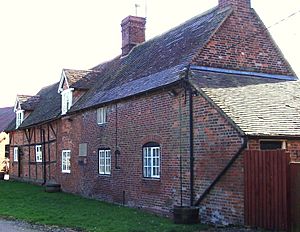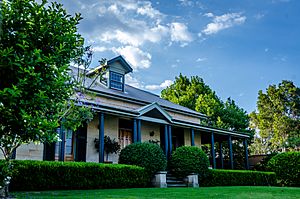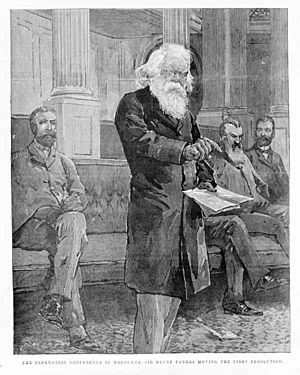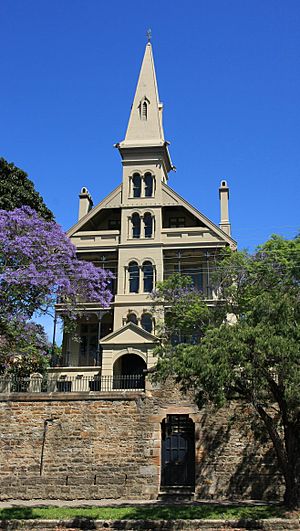Henry Parkes facts for kids
Quick facts for kids
The Honourable Sir
Henry Parkes
|
|
|---|---|
 |
|
| 7th Premier of New South Wales | |
| In office 14 May 1872 – 8 February 1875 |
|
| Monarch | Victoria |
| Governor | Sir Hercules Robinson |
| Preceded by | WAS; Sir James Martin |
| Succeeded by | WAS; Sir John Robertson |
| Constituency | Mudgee East Sydney |
| In office 22 March 1877 – 16 August 1877 |
|
| Monarch | Victoria |
| Governor | Sir Hercules Robinson |
| Preceded by | Sir John Robertson |
| Succeeded by | Sir John Robertson |
| Constituency | East Sydney |
| In office 21 December 1878 – 9 January 1883 |
|
| Monarch | Victoria |
| Governor | Sir Hercules Robinson Augustus Loftus |
| Preceded by | James Farnell |
| Succeeded by | Sir Alexander Stuart |
| Constituency | Canterbury East Sydney Tenterfield |
| In office 25 January 1887 – 16 January 1889 |
|
| Monarch | Victoria |
| Governor | The Lord Carrington |
| Preceded by | Sir Patrick Jennings |
| Succeeded by | Sir George Dibbs |
| Constituency | St Leonards |
| In office 8 March 1889 – 23 October 1891 |
|
| Monarch | Victoria |
| Governor | The Lord Carrington The Earl of Jersey |
| Preceded by | Sir George Dibbs |
| Succeeded by | Sir George Dibbs |
| Constituency | St Leonards |
| Personal details | |
| Born | 27 May 1815 Coventry, Warwickshire, England |
| Died | 27 April 1896 (aged 80) Sydney, Colony of New South Wales |
| Resting place | Faulconbridge, New South Wales |
| Citizenship | British subject |
| Nationality | Australian |
| Political party | Free Trade Party |
| Spouses | Clarinda Varney (m. 1836 – d. 1888) Eleanor Dixon (m. 1889 – d. 1895) Julia Lynch (m. 1895 – 1896; his death) |
| Children | Thomas Clarinda Martha Clarinda Sarah Robert Mary Mary Edith Milton Lily Maria Annie Gertrude Varney Lily Faulconbridge Sydney Kenilworth Aurora Henry Cobden Charles Jessel |
| Profession | Statesman |
Sir Henry Parkes (born 27 May 1815 – died 27 April 1896) was a very important Australian politician. He served as the Premier of the Colony of New South Wales five times. This means he was the longest-serving leader in that colony's history.
Parkes is often called the "Father of Federation." This is because he worked hard to unite the six separate Australian colonies into one nation. He also spoke out against sending convicts to Australia. He was a big supporter of building more railways across the country.
In 1889, Parkes gave his famous Tenterfield Oration. This speech led to important meetings in 1890 and 1891. These meetings were the first steps towards creating the Commonwealth of Australia. Parkes died in 1896, five years before Australia officially became a federation.
Contents
Early Life & Moving to Australia
Henry Parkes was born in Canley, England, on 27 May 1815. His father, Thomas Parkes, was a small farmer. Henry did not go to school for very long. From a young age, he worked hard in jobs like rope-making and brick-making.
He taught himself by reading many books. He also became interested in writing poetry. In 1836, he married Clarinda Varney. They struggled to make enough money. Sadly, their first two children died when they were very young.
Journey to New South Wales
In 1839, Henry and Clarinda decided to move to New South Wales. They arrived in Sydney on 25 July 1839. They had very little money when they arrived.
Parkes found work as a labourer on a large farm. Later, he worked in Sydney in different jobs. He then got a steady government job. He inspected merchant ships to stop smuggling. This helped him and his family financially.
He continued to write poetry and published a book called Stolen Moments in 1842. He also met important writers and editors who helped him. In 1846, he left his government job after a disagreement.
After this, Parkes tried working for himself. He was an ivory and bone turner and ran his own shop. He even owned several newspapers, including the Empire. However, he was not very successful in business. He often faced money problems.
Early Political Involvement
Henry Parkes became very interested in politics in Australia. He joined the movement that wanted the colony to govern itself. He also spoke out against sending more convicts to Australia. He supported changes to how land was owned.
He shared his political views in newspapers. In 1848, he helped Robert Lowe win an election. The next year, Parkes supported a request for more people to be allowed to vote. He even spoke in favour of universal suffrage, meaning everyone should have the right to vote.
In 1849, Parkes protested against a ship bringing convicts to Sydney. He kept fighting against convict transportation. The British government finally stopped it in 1853.
In 1850, Parkes started his own newspaper, the Empire. It became a daily newspaper. He wanted the paper to give a voice to people who criticised the government. He also spoke against plans for self-governance that he felt were not fair enough.
Joining the Legislative Council
In 1854, a politician named William Wentworth left his seat. Henry Parkes ran for the open position in Sydney City and won. He promised to give more power to the people. He also promised to improve education and support railway building.
Parkes started his political career quietly. He was part of the smaller group in the Legislative Council. He focused on his newspaper, but it was not making money. In 1856, he resigned from parliament to try and save his newspaper business.
Entering the Legislative Assembly
In 1858, Parkes was elected to the New South Wales Legislative Assembly. This was the main elected part of the government. However, he had to resign again because of his financial problems. He had a lot of debt.
After sorting out his money issues, Parkes was elected again for East Sydney in 1854. He was known as a "radical" politician. He supported free trade, which meant fewer taxes on goods coming into the colony. He also pushed for more immigration and better education.
He believed in growing both farming and manufacturing industries. Parkes introduced laws to fund public schools and train teachers. He also worked to improve prisons.
Working for Immigration
Parkes strongly believed in immigration. In 1861, he was sent to England. His job was to encourage people to move to Australia. He gave about 60 speeches in England and Scotland. He felt he did good work.
In 1866, Parkes became the Colonial Secretary. This was a very important role. During this time, he introduced the Public Schools Act of 1866. This law made sure teachers were trained. It also created a way to fund schools. Many new schools were built across the colony. Parkes also helped bring nurses trained by Florence Nightingale from England to Australia.
In 1868, Alfred, Duke of Edinburgh, Queen Victoria's son, visited Australia. He was shot by a man. The Duke was not seriously hurt. Parkes reacted strongly to this event. This caused some political challenges for him. He resigned from the government in September 1868.
First Time as Premier
In 1870, Henry Parkes faced money problems again. He had to resign from parliament. However, he was quickly re-elected. In 1871, he was elected for Mudgee.
In May 1872, Parkes formed his first government as Premier. This government lasted for almost three years. Parkes was a strong supporter of free trade. During his time as Premier, he reduced taxes on imported goods. This made New South Wales almost a free trade colony. His government also supported building railways and telegraph lines.
In 1875, his government was defeated. This happened over a disagreement about a prisoner's release.
More Time as Premier
After his first term, Parkes was out of office for a while. He became Premier again for five months in 1877. The political parties were very evenly matched. This made it hard to get things done.
In December 1878, Parkes formed his third government. This time, he teamed up with his old rival, Sir John Robertson. This was unexpected. But it led to two years of stable government. They changed election laws. They brought in a new education act. They also improved water and sewerage systems. They made laws to protect workers too.
In 1881, Parkes' health was not good. He decided to visit England at his own expense. He also visited America on the way. In England, he was welcomed as an important guest. He met famous people like Tennyson. He returned to Sydney in August 1882.
Later Political Career & Federation
When Parkes returned, his government was defeated over land reform. He even lost his own seat in parliament. He was elected again for Tenterfield. But he took less interest in politics for a while. He went to England again for business. He returned in 1884. He then announced he would retire from politics.
However, he could not stay away for long. In 1885, he was elected again. In January 1887, Parkes became Premier for the fourth time. He pointed out that the colony's debt had grown a lot. He brought back free trade. He worked to make the railway system free from political influence.
Parkes also spoke out against Chinese immigration. He believed it was important to protect the culture of his own nation. His government passed a law that made it much more expensive for Chinese people to enter the colony.
The Push for Federation
In March 1889, Parkes formed his fifth government. During this time, the idea of joining the Australian colonies into a federation became a major issue. Parkes had supported this idea for many years.
On 24 October 1889, Parkes gave his famous Tenterfield Oration. In this speech, he called for a meeting. The goal was to create a constitution for a federal government and parliament. This speech is seen as a very important moment in the push for Federation.
Parkes organised the 1890 Federation Conference. This was the first real step towards Federation. In 1891, he led the National Australasian Convention. There, the first draft of a bill to create the Commonwealth of Australia was written. Parkes even suggested the name "Commonwealth of Australia" for the new nation.
In October 1891, Parkes resigned as Premier. He was 77 years old. He continued to push for Federation as an independent politician. He believed the public should vote on the new constitution.
Parkes faced more money problems towards the end of his life. He had to sell some of his valuable belongings. He died on 27 April 1896, living in poverty. He was buried next to his first wife at Faulconbridge.
Legacy
Sir Henry Parkes is remembered as a very important figure in Australian history. He was called "the most commanding figure in Australian politics" by The Times newspaper. He was a powerful speaker. He worked hard for his beliefs.
Five years after Parkes' death, Australia became a federation on 1 January 1901. The conferences and discussions that led to this were directly started by Parkes.
Parkes was known for his strong personality. He spoke simply to his supporters. He was very determined. Even though he had little formal education, he taught himself by reading widely.
While he struggled with his own money, his governments managed their finances well. He supported improving life for working-class people.
Family Life
Sir Henry Parkes was married three times. He had many children.
- His first wife was Clarinda Varney. They married in 1836. They had twelve children. Clarinda died in 1888.
- His second wife was Eleanor Dixon. They married in 1889. They had five children. Eleanor died in 1895.
- His third wife was Julia Lynch. They married in 1895. They had no children. Julia helped raise his children from his second marriage.
Two of his sons also became well-known:
- Varney Parkes was an architect and a member of parliament.
- Cobden Parkes became the New South Wales Government Architect.
Honours
Henry Parkes received several honours for his service:
- He was made a Knight Commander of the Order of St Michael and St George in 1877.
- He was made a Knight Grand Cross of the same order in 1888.
His image has appeared on Australian money. This includes the one-dollar coin and a special five-dollar note.
Literary Works
Parkes also wrote poetry and prose. He published six books of poems. Some of his poems are still included in Australian collections today.
His prose works include Australian Views of England (1869). He also wrote his autobiography, Fifty Years in the Making of Australian History (1892). He also published collections of his speeches.
Legacy and Memorials
Henry Parkes Oration
The Henry Parkes Foundation holds an annual event. It is called the Henry Parkes Oration. It started in 2001.
Named After Him
Many places and things are named after Sir Henry Parkes:
- The Division of Parkes, an area represented in the Australian Parliament.
- HMAS Parkes, a Royal Australian Navy ship.
- Parkes, New South Wales, a regional town.
- Parkes, Australian Capital Territory, a suburb in Canberra.
- Parkes Observatory, a famous radio telescope.
- Parkes Way, a road in Canberra.
- Sir Henry Parkes Memorial School in Tenterfield.
- Sir Henry Parkes School of Arts, where he gave his famous "Tenterfield Oration."
In his birthplace of Canley, England, there is a road (Sir Henry Parkes Road). There is also a school (Sir Henry Parkes Primary School) named after him.
See also
 In Spanish: Henry Parkes para niños
In Spanish: Henry Parkes para niños
- Chief Secretary's Building – The office building Parkes worked in, and helped design and furnish







